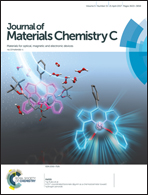Glycerol/PEDOT:PSS coated woven fabric as a flexible heating element on textiles†
Abstract
A polyamide 6,6 (PA66) fabric pre-treated with a double barrier dielectric (DBD) atmospheric plasma in air was coated with 1 and 5 layers of an intrinsically conducting glycerol-doped PEDOT:PSS polymer (PEDOT:PSS + GLY) with the final objective of developing a cost-competitive and temperature controllable flexible-heating element to be used in clothing encapsulated between an outer and an inner separator layer in order to provide heat-reflecting properties and uniform temperature distribution, respectively. FTIR, DSC, TGA, SEM, EDS, XRD and DMA analyses show significant changes in morphology, chemistry, enthalpy, crystallinity and glass transition temperature confirming that PEDOT:PSS and glycerol are not only spread over the PA66 yarn surfaces but are dispersed in the bulk facilitating relaxation and increasing structure and chain flexibility. Electrochemical and electrical resistivity (ρ) measurements confirm that the plasma treated PA66 coated with 5 layers of PEDOT:PSS + GLY presents the highest stability, resistance and capacitive behaviour, and the best capability of storing electrical energy. This configuration needs only 7.5 V to induce a temperature change up to 38 °C at a current density of 0.3 A g−1. The desired temperature is easily adjustable as a function of the applied voltage and by the number of coated layers of PEDOT:PSS + GLY. Despite the need to improve the uniformity of the coating thickness on the fabric for uniform heat generation, the observed results are quite impressive since they can be compared to the temperature obtained in carbon nanotube composites using similar voltages. This cost-competitive, safe, highly flexible and stable thermoelectric fabric has potential for use in large area textiles as a heating element in a wide range of applications such as garments, carpets, blankets and automotive seats.



 Please wait while we load your content...
Please wait while we load your content...